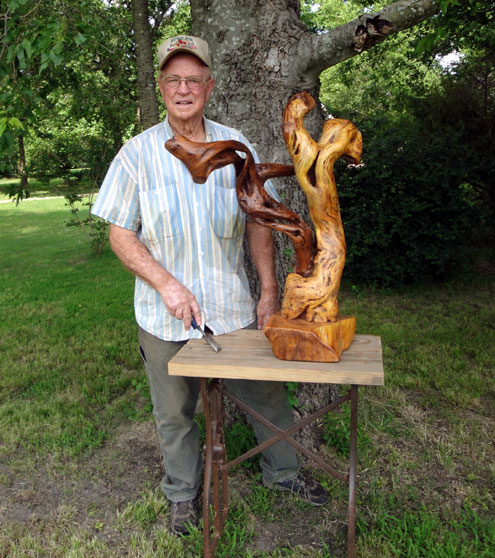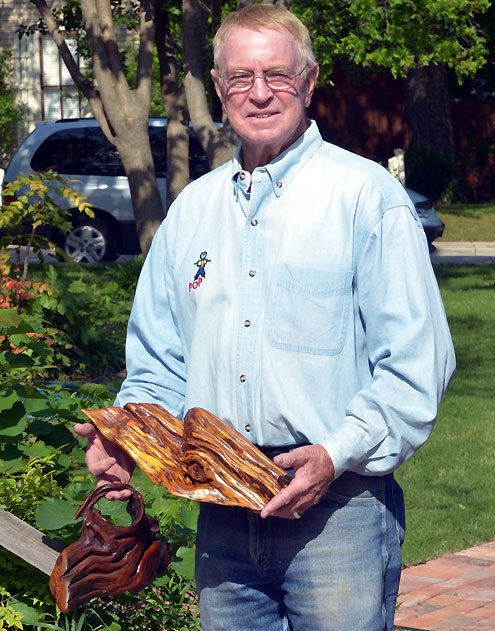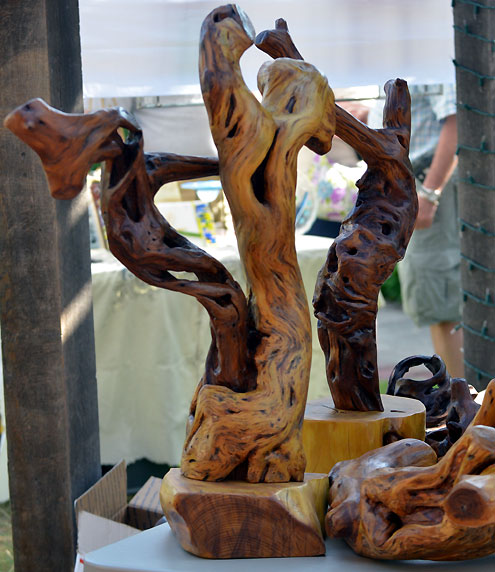Since Jerry Lytle startled Texas art lovers with the debut of his natural bois d’arc sculptures at a festival on Chestnut Square in McKinney in May 2011, the Commerce native has been settling into his new role as an artist.
Each McKinney viewer discovered the unique contours of bois d’arc branches making u-turns, spiraling, and melding; the blond hues of sapwood rings; the bright orange and chocolate colors of heartwood enclosing annual growth rings, all exposed by Lytle’s probing and polishing. The overall impressions inspired such names as “Ballerina,” “Elephantasy,” and “Bellissima” for the works of art.
Lytle’s calendar is filling with exhibitions of his work scheduled at the Cooper Review office in Cooper from June 16 through June 30, at the Osage, Oklahoma, County Historical Society Museum in Pawhuska on August 13, and at the Caddo Mills, Texas, Museum in early fall.
Lytle’s natural sculptures from the densest and heaviest wood in North America weigh from ten to seventy-five pounds each. From the day he discovers a branch of the tree nurtured by mud in a stream or seasoned in pastureland at his family farm near Commerce, Lytle looks for the potential of the awkward pieces of bois d’arc. Then he subjects the wood to his drills, chisels, grinders, rasps, grinders, sanders, saws, planes, oils, and polyurethane that reveal bois d’arc’s hidden mystique.

Scores of hours and several days later, a completed work of art rests on his work table. Lytle modestly gives all the credit to the tree, but his friends know that without Lytle’s skills and affinity for bois d’arc, the transformation would never evolve.
Born in Commerce on Halloween and raised a few miles east on a Hopkins County farm near the South Sulphur River about four miles from its flow into Cooper Lake, Lytle had settled comfortably into many earlier roles in the community. Known as “Red” for the red tints in his blondish hair, Lytle was well-known as the fullback for the Commerce High School Tigers.
“Up against district rivals like Mount Vernon, Bonham, and Sulphur Springs, our senior class of thirty-two had only eleven boys," says Lytle. "We lost our last seventeen high school games, and injuries convinced me that my football career would end after high school."
However, he continued to play college football for a team at East Texas State College, where the Lions won thirty games in a row, Lytle recalls.
After completion of three degrees in industrial education, broad field science, and secondary and higher education from the institution that is now Texas A&M University-Commerce, Lytle assumed other roles. He taught and coached in Longview, Dallas, and Commerce, served as elementary school principal in Commerce. He fondly recalls an essay written by a fourth grader who declared her principal an accomplished hay hauler. The student’s praise never extended to artistic skills later honed by the administrator.
Later Lytle became director of financial aid and student placement at A&M-Commerce. His office began with $600,000 in annual financial aid, growing to $6,000,000 when he retired thirty-two years later. He was elected president of the 3,000 Texas financial aid administrators, winning an election in which he was a write-in candidate.
Upon retirement from A&M-Commerce, Lytle busied himself with community projects and spent more and more time with bois d’arc, fashioning walking canes and hiking sticks for his friends while collecting unusual tree conformations that intrigued him. Whatever he made was always bestowed as a gift until he joined the Bois d’Arc Capital Crafters in the fall of 2010 to promote cottage industry crafts in Commerce. The Commerce Bois d’Arc Bash began in 1986 as an annual fall festival. The state legislature named Commerce the Bois d’Arc Capital of Texas in the 1990s, and recently Fred Tarpley of Commerce and Allen Rich of Bonham have become prime ministers of the Bois d’Arc Kingdom formed by Northeast Texas counties with the distinction of having the only native habitat in the world where the bois d’arc tree survived after the last ice age 12,000 years ago.

The Kingdom will promote appreciation for uniqueness of the tree and develop tourist destinations featuring bois d’arc. For example, the Kingdom will encourage visits to Commerce for the Bois d’Arc Bash each September; for the thrill of hugging “Big Max,” the second largest bois d’arc tree in Texas (the champion is in New Boston); and to view the bois d’arc heritage exhibit at the Commerce Chamber of Commerce. Bonham features Bois d’Arc Creek, the first stream known to have taken its name from the native tree; a park north of the Bonham square, where hanging trees have reached senility; and Bois d’Arc Springs, where travelers forded Bois d’Arc Creek near Red River and carved their names on sandstone. In Farmerville a man made his fortune by cutting bois d’arc fence posts from Northeast Texas river bottoms and selling them to keep livestock from entering the railroad right of way all across the state of Arkansas. Other bois d’arc destinations in the Kingdom will appear on a map now being researched to direct visitors to these and other sites.
Lytle’s major contribution to the Bois d’Arc Capital had been his discovery of the trunk of a large bois d’arc tree beside the South Sulphur River on Highway 24. As he jogged past the trunk that had been pulled out of the river by the highway department, he envisioned it as an attraction for children in Commerce City Park. With the assistance of Fred Tarpley, Bois d’Arc Bash director at the time, and a Commerce hauling firm, Lytle saw the trunk transported to the park. It became a favorite attraction for children who walked along its gnarled trunk or crawled through the tunnel at the broad end of the tree. After decades in the park, the tree was taken away by a city maintenance crew that discovered bees were also attracted to the hollow of the tree.
With his involvement as a member of the Bois d’Arc Capital Crafters, Lytle increased his output of useful and decorative objects, displaying and selling items at the Bois d’Arc Bash and two Christmas bazaars. In addition to his larger items, his handsome paper weights allowing owners to count annual growth rings, and his “forever sticks” were especially popular.
The forever sticks were originally presented to Lytle’s grandchildren with a laminated bookmark explaining, “Keep your forever stick in a safe place and visit it often. This wood will last forever, just like your grandfather’s love.” But it wasn’t until Lytle exhibited a dozen of his provocative natural bois d’arc sculptures at Chestnut Square that artistic fame crashed down upon him.
Now friends and strangers ask, “How long have you been an artist? How do you create these wonderful shapes? How do you bring out the distinctive colors?"
Lytle is growing into his perceived role as a serious artist. He patiently describes his transitions from bois d’arc admirer, to collector, to craftsman, to artist. He has theories about what natural forces created the unusual shapes—winds, tornadoes, injuries, overcrowding. Lytle still gives credit to nature for most of the unique contours. He can account for the varying natural hues of parts of bois d’arc and explain the effects of oils and chemicals applied to preserve or accentuate hues and grains.

Lytle often reverts to his high school and college training in industrial education. Although he frequently uses a sharp chisel, he has never injured himself.
“Mr. Myrick, our teacher, told us, ‘Never get in front of your chisel.’ I’ve rememberd that,” Lytle smiles.
Lytle has also profited from being the number one fan and supporter of his wife, Debora, who is a nationally recognized portraitist. She has painted the portraits of three recent presidents of Texas A&M University-Commerce, and she was selected by a national organization to paint the portrait of a fallen New York fireman at 9-11 ground zero and to present the picture to his family. From his artist wife, Lyle has observed her answers to questions, her responses to compliments, and her patience with those who do not understand her craft.
Friends say that Lytle is still the easygoing, modest, generous friend they have enjoyed for years, but they see fame for him just around the corner. So impressed with his art are Allen Rich and Fred Tarpley, prime ministers of the Bois d’Arc Kingdom, that they believe every home and every professional office in the Kingdom will want to display a Lytle natural sculpture on an appropriate pedestal in recognition of a regional treasure. Plans are being complete to place some of the sculptures on tour in the offices of county judges within the Kingdom.
Although by no means a recluse, Lytle finds himself spending more and more time by himself.
He recalls his father’s fondness for solitude and his frequent comment, “You have good company when you are by yourself.”
Lytle now recognizes his father’s sagacity. With a score of tools, he exposes hidden delights in his pieces of bois d’arc, digging into weak spots that open new crevices. He theorizes about wind flows, breaks, and splits, which are filled with bark and are gently encircled by sapwood. His artistic senses and appreciation for nature’s art erupts daily at his bois d’arc workshop. The artist’s name is Jerry Lytle. His telephone is 903-886-2688. A modest JL etched into each of his works identifies the artist.